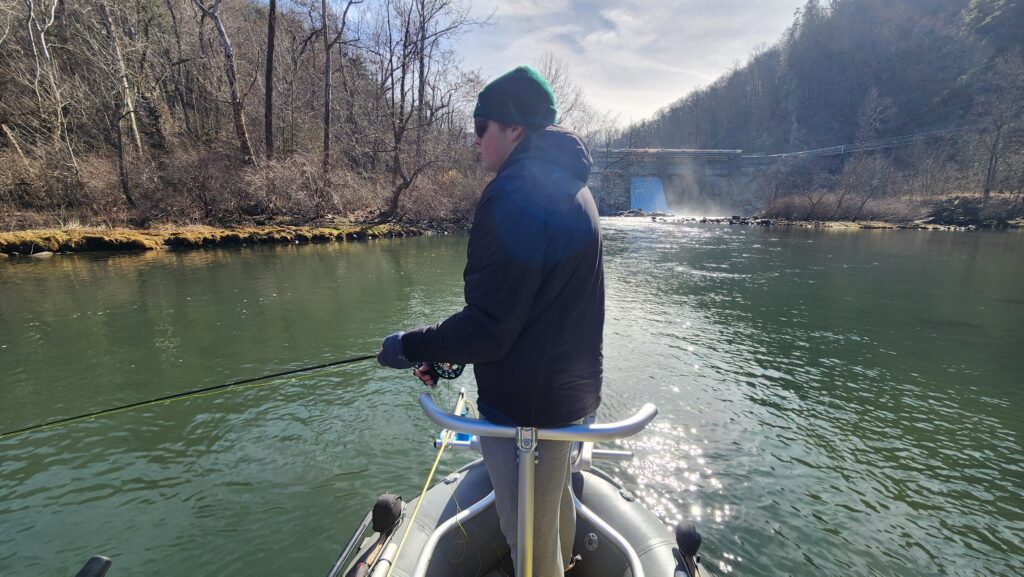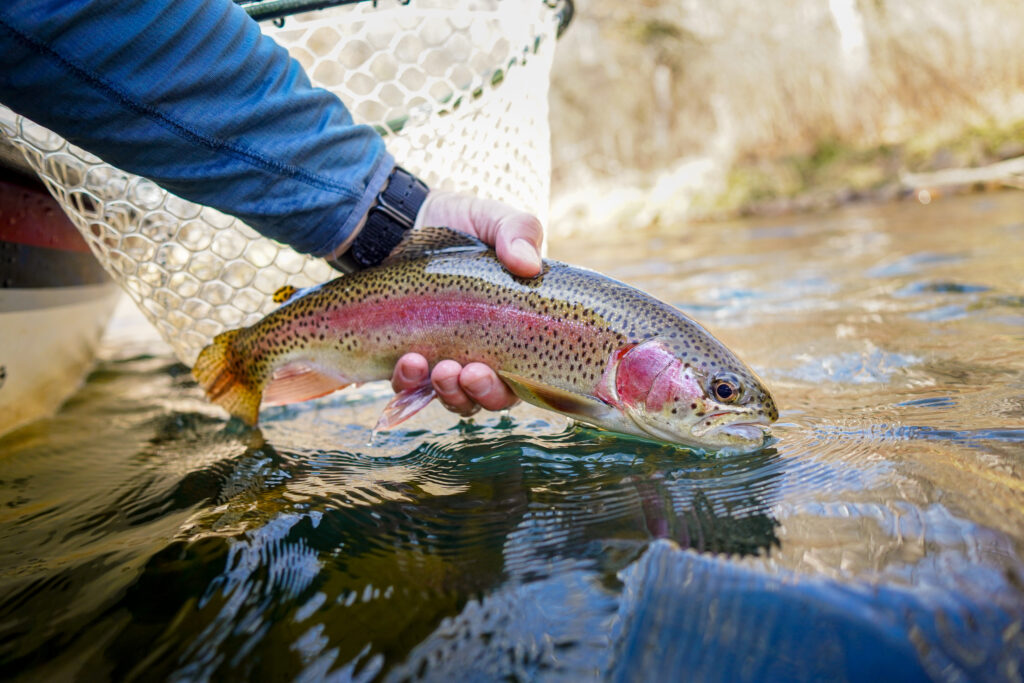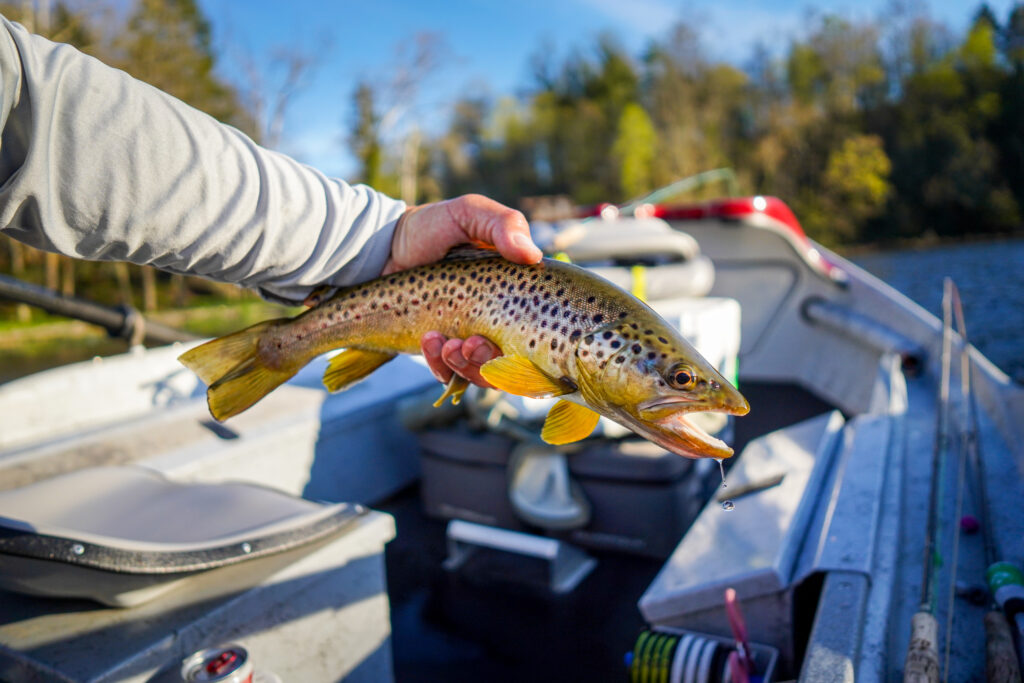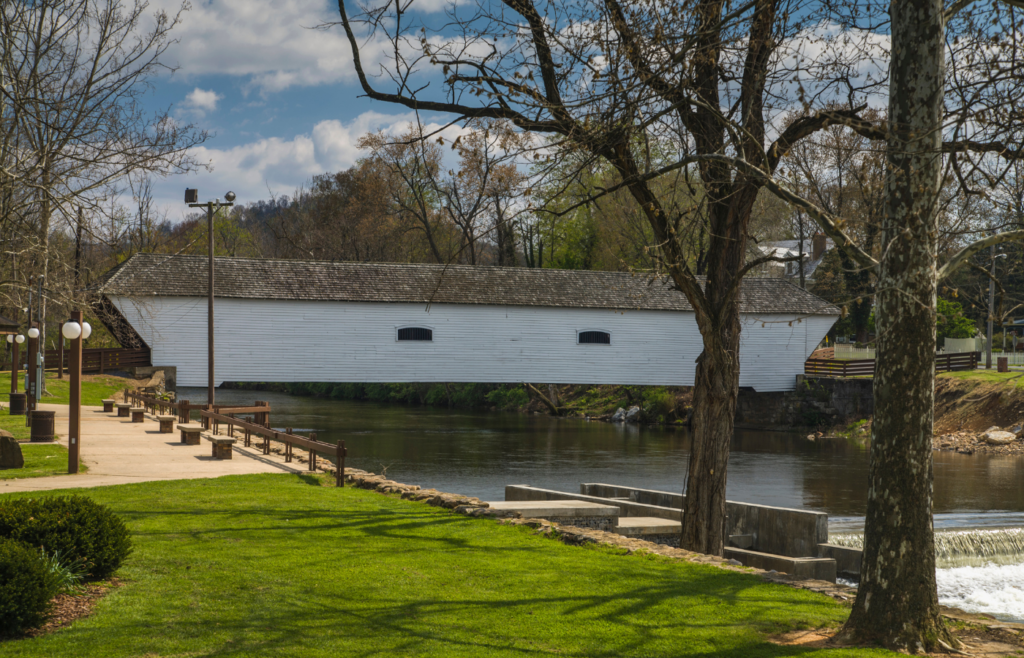Fly Fishing the Watauga River: A Complete Guide
Fly fishing the Watauga River in Elizabethton, Tennessee, is a coveted destination for anglers in the Southeast. Renowned for its clear, cold waters and the prolific aquatic life they support, the river offers anglers a premier setting for chasing trout. The Watauga River’s reputation in the fly fishing community is well-earned, attracting enthusiasts from all over who seek the thrill of hooking rainbow, brown, and occasionally brook trout. Its tailwater section, in particular, benefits from the constant flow from Wilbur Dam, creating ideal conditions for trout to thrive year-round.

What sets the Watauga apart is not just the opportunity for exceptional fly fishing but its ecological richness. The river boasts a diverse ecosystem, providing habitats for a wide array of fish species and aquatic insects. This biodiversity makes the Watauga a fascinating study in environmental health, with its waters serving as a testament to successful conservation efforts. Anglers here are treated to a fly fishing experience that is as rewarding for the beauty and variety of life it presents as for the sport itself. The Watauga River embodies the essence of fly fishing—challenging, serene, and deeply connected to the natural world.
Understanding the Watauga River Tailwater
Brief Geographical and Ecological Background
Nestled in the scenic landscapes of Northeast Tennessee, the Watauga River tailwater emerges from the depths of Wilbur Dam, near the town of Elizabethton. This river section meanders through a breathtaking valley, framed by the Appalachian Mountains, before joining the waters of the South Holston River to make up Boone Lake. The geographical and ecological setup of the Watauga, coupled with the controlled discharges from Wilbur Dam, ensures a consistent flow of cold, oxygenated water, creating an ideal habitat for trout.
Importance of Tailwater Fisheries for Fly Fishing
Tailwater fisheries like the Watauga River are pivotal to the fly fishing community. They offer anglers dependable fishing conditions throughout the year, thanks to the temperature-regulated water releases from upstream dams. This stability is essential for maintaining robust populations of aquatic insects, which in turn foster a vibrant ecosystem where trout can flourish. Tailwaters are prized for their reliable fishing opportunities and for the quality of the angling experience, especially in areas where seasonal temperatures can greatly impact fishing in non-tailwater streams.
Unique Aspects of the Watauga River Ecosystem
The ecosystem of the Watauga River is remarkable for its exceptional biodiversity. Its cold, nutrient-dense waters harbor a vast array of aquatic insects, including mayflies, caddisflies, and stoneflies, crucial for the diet of trout. This abundance of food supports healthy populations of both brown and rainbow trout, making the Watauga a prime destination for anglers. Moreover, the river benefits from thoughtful management practices focused on ecological health, ensuring it remains a sustainable fishery for future generations.
Additionally, the ecosystem is enriched by the surrounding environment, which provides habitat for various wildlife, adding to the area’s natural beauty and ecological diversity. The unique blend of geographical features, ecological richness, and diligent management establishes the Watauga River tailwater as an exemplary fishery, underscoring the significance of preserving these natural resources for the enjoyment and benefit of future anglers.

Best Sections for Wade Fishing on the Watauga River
Overview of Accessible Wade Fishing Spots
The Watauga River, with its diverse terrain and abundant trout populations, offers several prime spots for wade fishing. These areas, known for their accessibility and productive waters, provide anglers with the opportunity to engage closely with the river’s ecosystem. Key spots include the section below Wilbur Dam, the Siam Bridge area, and the stretch near the TVA access point at Hunter Bridge.
Detailed Descriptions of Each Spot
Below Wilbur Dam
This section features a rocky bottom with swift currents near the dam, gradually transitioning to slower-moving waters downstream. The varied water flow creates excellent habitats for trout, where anglers can find pockets and pools teeming with fish. Due to the proximity to the dam, water levels can change, so it’s crucial to stay informed about release schedules.
Siam Bridge Area
Siam Bridge offers a mix of shallow riffles and deeper runs, ideal for targeting both rainbow and brown trout. The terrain here is moderately easy to navigate, with some areas requiring a bit more caution due to slippery rocks. This spot is particularly known for its evening hatches, making it a favorite for dry fly enthusiasts.
TVA Access Point at Hunter Bridge
This location provides easy access to a wide section of the river with a gentle flow, making it perfect for beginners or those preferring less challenging wading conditions. The riverbed here is mostly gravel, with scattered boulders creating ideal holding spots for trout.
Tips for Safe Wading and Maximizing Success
Always check the water release schedules before planning your trip to ensure safe wading conditions.
Wear quality wading boots with good grip to navigate slippery rocks and uneven riverbeds safely.
Use a wading staff for additional stability in faster currents or uneven terrain.
Approach fishing spots quietly and with minimal disturbance to avoid spooking the fish.
Observe the water and look for signs of fish activity, such as rising fish, hatches, or nymphs moving in the current.
Practice catch and release to help maintain the Watauga River’s trout population for future anglers.
Best Sections for Float Fishing on the Watauga River
Overview of Ideal River Sections for Float Fishing
The Watauga River, renowned for its excellent trout fishing, offers distinct sections each providing unique float fishing experiences. These include the Upper Section from Wilbur Dam to Hunter Bridge, the Middle Section from Hunter Bridge to Blevins Rd Boat Ramp, and the Trophy Section from Blevins Rd Boat Ramp to Persinger Rd Boat Ramp. Each segment of the river caters to anglers with different preferences, ranging from challenging rapids and deep pools to serene stretches abundant with trophy-sized trout.

Upper Section: Wilbur Dam to Hunter Bridge
This stretch is characterized by its cold, clear waters, directly influenced by the consistent releases from Wilbur Dam. Ideal for targeting a variety of trout, this section offers both rapid flows and slower pools. Launching can be done just below the dam, with take-out points available at Hunter Bridge. This area is perfect for anglers looking for diverse water conditions and the opportunity to catch both rainbow and brown trout.
Middle Section: Hunter Bridge to Blevins Rd Boat Ramp
Moving downriver, the Middle Section presents a mix of riffles, runs, and deeper pools, offering excellent habitat for large trout. The terrain here becomes slightly more challenging, making navigation exciting yet rewarding. Access for launching is readily available at Hunter Bridge, with the journey ending at Blevins Rd Boat Ramp. This section is particularly noted for its scenic beauty and the chance to connect with the river’s natural environment.
Trophy Section: Blevins Rd Boat Ramp to Persinger Rd Boat Ramp
As its name suggests, the Trophy Section is where anglers can expect to encounter larger trout, thanks to the fertile waters and abundant food sources. This part of the river offers a blend of technical fishing spots and areas where the water widens, allowing for easier navigation and casting. Starting at Blevins Rd Boat Ramp and concluding at Persinger Rd Boat Ramp, this section is a must-fish for those aiming to land a trophy-sized catch.
For each of these sections, it’s essential to be mindful of water levels and flow rates, which can vary based on dam releases and weather conditions. Safety should always be a priority, so wearing life jackets and using stable, river-appropriate floatation devices is recommended. Additionally, respecting the river’s natural beauty and practicing catch and release ensure that the Watauga River remains a premier destination for fly fishing enthusiasts.

Best Times of Year to Fish the Watauga River
The Watauga River, with its diverse sections and tailwater characteristics, offers year-round fishing opportunities. However, understanding the seasonal patterns and how they influence fish behavior and hatches can greatly enhance the fly fishing experience.
Spring
Spring on the Watauga brings about a resurgence of life, both in and around the river. As temperatures begin to warm, aquatic insect activity increases, leading to significant hatches of mayflies, caddisflies, and midges. This period is characterized by active trout feeding on the surface, making it an ideal time for dry fly fishing. The water levels are generally stable, thanks to controlled releases from the dam, but be mindful of the occasional rainfall that can increase flows temporarily.
Summer
The warm months continue to offer excellent fishing, especially early in the morning and late in the evening when temperatures are cooler. During this time, terrestrials become a significant part of the trout’s diet, along with the continued presence of aquatic insects. The stable cold water from the dam keeps the fish active, even on the hottest days.
Fall
Fall is a favorite among many anglers due to the beautiful foliage and the aggressive feeding behavior of trout as they prepare for winter. Brown trout spawn in the fall, making them more aggressive towards streamers and egg patterns. Hatches of blue-winged olives are common, providing exciting dry fly fishing opportunities.
Winter
Winter fishing on the Watauga can be surprisingly productive. The cold, clear water and fewer anglers on the river create a serene fishing environment. Midges dominate the hatches during this time, and trout can be found in slower, deeper waters conserving energy. Dressing in layers and being prepared for colder temperatures is crucial for a comfortable fishing experience.
Each season on the Watauga River offers something unique, from the hatches to fish behavior and weather patterns. Adapting techniques and fly selections to match these conditions will increase your chances of a successful day on the water.
Fly Selection on the Watauga River
The key to a successful fly fishing adventure on the Watauga River lies not just in skill or knowledge but significantly in the choice of flies. The river’s diverse ecosystem, influenced by seasonal changes and varying water conditions, demands a strategic selection of flies to effectively match the local hatches and entice the trout.
Importance of Fly Selection
Understanding the feeding patterns of trout and the prevalent hatches during different times of the year is crucial. The right fly not only mimics the natural diet of the trout but also increases your chances of a memorable catch. Fly selection on the Watauga River can vary widely from season to season, making versatility and adaptability your best tools.

Top Fly Recommendations
Spring to Summer
Nymphs: Pheasant Tail and Hare’s Ear Nymphs are effective in mimicking the natural aquatic insects. Sizes 14-18 can match the majority of the hatches.
Emergers: Blue Winged Olive and Caddis Emergers are essential during this period, especially during late afternoons when hatches are most active.
Dry Flies: Sulphur Duns and Elk Hair Caddis in sizes 14-18 excel in matching the surface activity of trout feeding on emerging insects.
Fall to Winter
Streamers: Woolly Buggers and Zonkers in olive, brown, or black imitate the baitfish and larger nymphs trout feed on aggressively before the winter. They are particularly effective in the fall.
Nymphs: Midges in smaller sizes (18-22) become crucial as the diet of trout shifts towards these smaller insects in colder months.
Matching Local Hatches
Paying attention to the specific hatches occurring on the river is paramount. For instance, during a Sulphur hatch in late spring, matching the size and color with a Sulphur Dun can be the difference between a successful and an uneventful day. Similarly, knowing when Caddis are active and switching to an Elk Hair Caddis can significantly improve your catch rate.
Your selection of flies for fishing the Watauga River should be thoughtful and informed by the current conditions and prevalent hatches. Being prepared with a variety of nymphs, emergers, dry flies, and streamers, and knowing when to use them, will put you in the best position for a successful day on the water.

Off-River Activities Near Elizabethton, TN
While the Watauga River offers exceptional fly fishing, the area around Elizabethton, TN, is rich with activities and attractions for when you’re not on the water. Whether you’re looking to explore the local culture, enjoy some downtime, or gear up for your next fishing adventure, Elizabethton and its surroundings have plenty to offer.
Local Attractions
Sycamore Shoals State Historic Park: Dive into the area’s history with a visit to Sycamore Shoals, which plays a pivotal role in the early frontier history. The park offers walking trails, historical reenactments, and a visitor center.
Tweetsie Trail: For those who enjoy the outdoors off the river, the Tweetsie Trail provides a scenic walking and biking path between Johnson City and Elizabethton, perfect for a family outing or a solo adventure.
Lodging and Dining
Lodging: Elizabethton hosts a range of accommodations, from cozy bed and breakfasts to comfortable hotels. Consider staying at the Watauga River Cabins for a charming riverside experience or the Hampton Inn for familiar comforts.
Dining: Refuel after a day on the river at local favorites like The Coffee Company for a casual breakfast or lunch, and enjoy a hearty dinner at Jiggy Ray’s Downtown Pizzeria, known for its lively atmosphere and delicious food.
Local Fly Shops and Community Events
Local Fly Shops: Stop by the local fly shop, Hellbender Outfitters, for the latest fishing reports, gear, and expert advice on fly selection. It’s also a great place to connect with the local angling community.
Community Events: Keep an eye out for fly fishing workshops, river clean-up events, and local fishing tournaments. These events are fantastic opportunities to learn more about the sport and contribute to the conservation of the river’s natural beauty.
Elizabethton and the surrounding area offer a welcoming community and a variety of activities to enrich your fishing trip, making it more than just a day on the river.
That’s a Wrap
The Watauga River, with its clear, flowing waters and abundant trout populations, stands as a testament to the beauty and bounty of Northeast Tennessee. Understanding the river’s dynamics, the behaviors of its fish, and the essence of the surrounding community is crucial for any angler seeking a fulfilling fly fishing experience. This guide has journeyed through the prime fishing sections, seasonal strategies, essential fly selections, and even the vibrant life beyond the riverbanks to prepare you for your adventure on the Watauga.
As you set forth, armed with knowledge and anticipation, remember to approach the river with respect. Respect for its natural rhythms, respect for the fish that call it home, and respect for the community that welcomes you. The Watauga River offers more than just a fishing experience; it invites you to become part of a larger story, one of conservation, camaraderie, and the sheer joy of fly fishing. So, wade into its waters with enthusiasm, cherish the quiet moments and the thrill of the catch, and let the Watauga River become a cherished chapter in your angling adventures.
